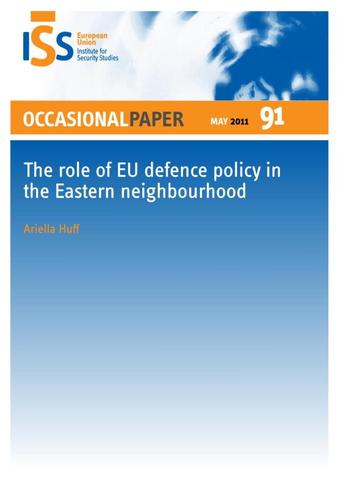You are here
The role of EU defence policy in the Eastern neighbourhood

The launch of the EU’s Eastern Partnership in 2009 intended to signal a new, elevated level of EU engagement with its Eastern neighbourhood. Yet there remain several long-simmering and potentially destabilising conflicts in the region, with which EU engagement thus far has been sporadic at best. The Union’s use of its Common Security and Defence Policy (CSDP) in the region to help solve these disputes has been particularly ad hoc and inconsistent, wracked by inter-institutional incoherence and undermined by Member States’ inability to agree on a broad strategic vision for engagement with the area. The three CSDP missions deployed to the region thus far have all suffered from this incoherence to various extents. In particular, all three were tasked with long-term mandates far beyond their real capabilities, largely for symbolic reasons. This reflects a perception, common in Brussels even after the Treaty of Lisbon, that the EU’s instruments are either ‘political’, like the CSDP, or ‘technocratic’, like the European Neighbourhood Policy (ENP). Yet the CSDP’s role as political symbol has only made Member States reluctant to deploy it in such a politically-sensitive region, and this artificial and unrealistic distinction between the two types of policy instruments has hampered the EU’s ability to use its wide variety of tools in an effective, coherent and long-term way. This paper argues that the creation of the External Action Service (EAS), as well as the relatively positive current climate of EU-Russia relations, offer an unrivalled opportunity for the EU to reconsider its approach to using CSDP to help resolve the conflicts in its Eastern neighbourhood. First, the EAS must develop a set of concrete and politically realistic policy aims for each of the three major disputes in the region: in Transnistria, Nagorno-Karabakh and the two breakaway provinces of Georgia, South Ossetia and Abkhazia. The EAS, together with the Directorate General for the ENP, should then plan together to use their various instruments in support of one another, rather than, as has too often been the case until now, merely brief one another on separate but parallel policies. The EU cannot solve these conflicts by itself. Yet there are concrete steps it can take in Transnistria, Georgia and even Nagorno-Karabakh to help bring about resolutions to these disputes, and it must be both willing and able to deploy CSDP missions and to support them with longer-term measures. With the establishment of the EAS, the Union is in a better position than ever to take full advantage of its unique range of social, political, economic and security tools. By seizing this rare opportunity to act now, the EU may be able to prevent the outbreak of destabilising violence on its Eastern borders in the future.